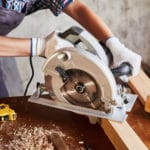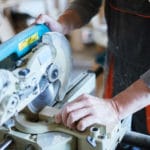Table saws are a very popular workshop tool. They’re found in most workshops and workrooms, and they have a wide range of uses. If you don’t know how to use one yet, or if you just need some help getting started with it, this blog post is for you!
This beginner’s guide will teach you about everything from table saw safety features to the best blade types. We’ll also explore how different kinds of wood react when being cut by your table saw.
What is a Table Saw and Its Uses?
A table saw is a power tool with a table or bench that allows for the cutting of large pieces of wood (typically plywood, but sometimes even logs). The wood is pushed against an extremely thin, flat, circular blade that has teeth coming from both sides of the blade.
The teeth on one side are set at an angle to the teeth on the other side, so when you move your wood back and forth across the blade it slides between two different sets of teeth which cuts through and removes it in slices.
There will be a moment when you are cutting through a piece of wood and you feel the saw slip when it bites into the wood. This is quite scary, especially if your hands were on top of or near the blade at this time. You’ll want to release any pressure that might be causing this slipping feeling while also carefully moving away from where you’re working so as not to get cut.
One of the most important features to look at when buying a table saw is its blade guard or guarding system.
The best guards will stop you from coming in contact with the moving blades, while also preventing any pieces that are being cut from flying out and injuring someone else nearby (or even yourself).
Table saws come in many different sizes, but most of the time you will choose between a contractor saw or a cabinet table saw. The difference is that while contractors typically use their tables for cutting plywood and other sheet goods, cabinet models are built into cabinets so they take up less space in your workshop.
Blade Types: Choosing the Right Blade for Your Situation
There are two main types of blades on table saws: rip and crosscut.
Rip Blades
Rip blades are best for cutting along the grain, meaning they want to follow the direction of a piece of wood’s fibers.
Crosscut Blades
Crosscut blades cut across that grain and will produce cleaner edges on your finished project pieces.
Both rip and crosscut blade types have teeth coming from both sides of their circular shape but in different configurations. A rip blade has teeth on one side that are set to the left of those on the other, while a crosscut saw’s teeth are set so they’re right next to each other.
The most commonly used type of wood when cutting with table saws is softwoods like pine or fir because these types don’t splinter as much and are easier to cut.
Wood Types: Different Types of Wood and How They React When Being Cut by a Table Saw
The first thing you need to know is that different types of wood react differently when being cut by a table saw. For instance, soft woods like pine and fir are easier to cut than hardwoods because the blade doesn’t have to be set as high.
Hardwood blades are more likely to splinter or break when used on softwoods because of the difference in densities.
Soft woods also produce more sawdust than hardwoods, so make sure you’re protecting yourself with a speaker or filter from this debris if it’s going to come into contact with your face and lungs.
Safety Features: What to do Before You Start and While Using Your Table Saw
The most important feature of a table saw is that it has a guard, which helps prevent accidental contact with the blade when it’s in use and can also reduce injury severity if you do get hit by an accident.
The guard should always be in place and working correctly to protect you.
A table saw also includes a trigger, which controls the blade’s power settings – switching them from high to low depending on what type of wood you’re cutting – and an emergency shut-off button that will turn the power supply for your machine off instantly if it is unintentionally activated.
Make sure you use the blade’s housing to protect yourself from injury by keeping your fingers away from the area it could cut through, and make sure that your other hand is also clear of this space when using a table saw manually – your own hand should not be stretched out or have any part touching the blade at all times.
What to do Before Using a Table Saw?
- Hold the wood with both hands, and pull it backwards against the saw blade. This is called push cutting.
- Keep your fingers well away from the blade, and never reach under the work piece while it is moving towards or away from you.
- Make sure your hands are off of the power switch, unplugged cords, and any electrical components.
- Read all owner’s manuals for risk warnings related to your specific model before putting it together.
What to do if Something Goes Wrong While Using a Table Saw?
- Release any pressure that might be causing your saw to slip by carefully removing your hands from the saw and taking a step back.
- Release the power button on your saw, unplug it from its electrical source, and turn off any other machinery that might be connected to the same circuit.
- Check for any loose clothing or jewelry near the blade before resuming work. These items can catch in moving parts of a table saw or get pulled into them by accident if they get too close.
- Check the area of your saw for any dropped or loose items before continuing to use it. If you notice a small object that could get pulled into the blades, move it away from the blade and out of harm’s way.
- Inspect your table saw for signs that something might have been caught in its power source – like a small piece of metal or an electrical cord.
- If you notice any damage to the saw, turn it off immediately and refer to your owner’s manual for information on what to do next.
- Keep all workshop kids away from these power tools at all costs! They could easily get tangled in moving parts, cut by sharp blades, or accidentally turn on the power without knowing how to.
What are Push Cuts?
Push cutting is when you hold and pull a workpiece against the blade as it moves past, rather than pushing its edge into the teeth of your saw’s blade. This can be done by hand, with a jigsaw, router table for wood, or a table saw.
What Can You Do if the Blade Doesn’t Cut all the Way Through a Work Piece?
Make sure your saw is on and set to an appropriate height for what you’re cutting.
If your saw’s depth of cut or blade height isn’t causing it to go low enough, try turning off the power supply before adjusting these settings.
Conclusion
The table saw is one of the most versatile tools in your workshop and can make quick work out of many tasks that would otherwise take a lot more time to complete by hand.
It’s important for any beginner woodworker or carpenter to know how to use their table saw properly so they don’t end up damaging themselves or the project at hand with an improperly adjusted blade or lack of safety precautions during operation.
We hope this guide has helped you discover some new tricks about using your own table saw as well as learn more about what types of blades are best suited for different jobs on various materials like plywood, hardwoods, and soft woods.




